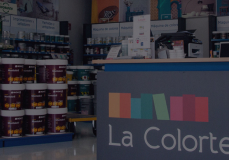Understanding the justified importance of such a pre-emptive analysis could prevent minor imperfections on a façade from leading to premature damage and severe humidity. And painting is a further element of construction, meaning that its selection requires going beyond aesthetic contributions and delving into its more technical features.
Types of façade claddings
Resin is the component with the most influence on the main characteristics of a façade cladding, such as its durability, elasticity, water vapour permeability, watertightness against rain, protection and enhancement of colour, etc. Therefore, it is important first of all to take into account the different types of coatings on the market and to appreciate which characteristics and properties are the most appropriate for each type of façade:
- Acrylic Coatings: These are notable for their ease of application. They have high impermeability and moderate breathability, both qualities which are determined to a great extent by the quality and quantity of the resin that they incorporate. These are the most commonly used coatings.
- Siloxane Coatings: These are especially suitable for those façades that require a perfect balance between resistance against rain water and water vapour permeability. Siloxane resins also contribute to the high-resistance coatings that impede the adhesion of the particles responsible for dirt on façades: dust, environmental pollution, mould, etc., keeping the surfaces to which they are applied cleaner for longer periods.
- Pliolite Coatings: Thanks to their high adhesion, these types of coatings are suitable for façades with issues of chalk or disintegration, even those that contain a certain degree of moisture. In addition, these types of resins are available as water-based or solvent-based products. As an added detail, the second type can also be applied in cold climates, at temperatures below 5ºC.
- Silicate Coatings: These are notable because of the very high breathability that they contribute to completely mineral-based surfaces such as cement and/or lime plaster, concrete surfaces and natural stone. Thanks to the tight petrification achieved with these materials, they are the ideal coating for the refurbishment of historical or listed façades. Their application is complex and requires qualified professionals who have experience with these types of products.
"There is no such thing as an ideal coating, just the coating ideal for a given surface."
Façade analysis
Once the different types of paint have been analysed, it is necessary to analyse the façade to choose the one that best suits your needs. To do this, you should keep the following factors in mind:
- The nature of your materials: Façades exist in multiple materials: natural stone, cement renders, lime, single-layer, etc., ceramic bricks, reinforced concrete, stone tiles, etc.... as such, finding the most appropriate type of coating for each one is key to ensuring that the rest of the process is successful.
- Condition of the existing coating: It is vital to assess the base you are working off. The façades on newer buildings may only require a clean prior to starting work. However, older façades will, in most cases, require removal of old paint, repairs to cracks, crevices and damp, and effective priming of the base material to regulate absorption before undertaking painting work. Other problems that may be present in such façades are carbonation, efflorescence, discolouration, flaking, etc. which will all require prior repair work.
- The climate of the geographical area: Cold areas with higher rainfall rates will require you to apply a product with a higher degree of impermeability, elasticity and breathability. On the other hand, in warmer areas the choice of colour and the resistance to ageing of the chosen colour should take precedence. Dark colours will absorb more solar radiation and be more prone to heating up than brighter colours. This quality will be determined by the value of its SRI or Solar Reflectance Index, a scale that is measured in values from 0 to 100, with 0 being the value of the colour that will absorb the most heat (black) and 100 the value of the most reflective colour, which will heat up less(white).
- Surface to be painted: For this purpose, the yield of the paint indicates how many square metres the paint can coat per litre. Knowing the surface area of the façade to be painted and the yield of the product will allow you to know, with almost total accuracy, the amount of paint that you are going to need. For a reliable calculation, be sure to prime the surface that you wish to paint with the most suitable product, so that the entire surface will absorb the same amount of paint.
The choice of colour is very important and you must make sure that your chosen product is coloured with inorganic pigments, since these are the only ones that are truly resistant to sunlight.
Colours provoke feelings: while lightly-coloured façades provide a light and airy feeling, those which are coated in dark tones provide a greater sense of ruggedness and reliability. However, any of these combinations may be interesting or necessary when it comes to merging a building with its environment. Usually, soft neutral colours are more resistant to the passage of time than darker colours. However, the choice of high-quality products allows any range of colours to be chosen, thanks to their protective properties and colour enhancement qualities.
In short, there are many details to keep in mind before preparing to paint a façade, and at Pinturas Montó we guarantee that setting aside some time for reflection, to choose the most appropriate façade cladding for each project, will make for effective and durable refurbishment work, and help maintain the condition of the façade and its resistance to poor weather conditions for a lot longer.


